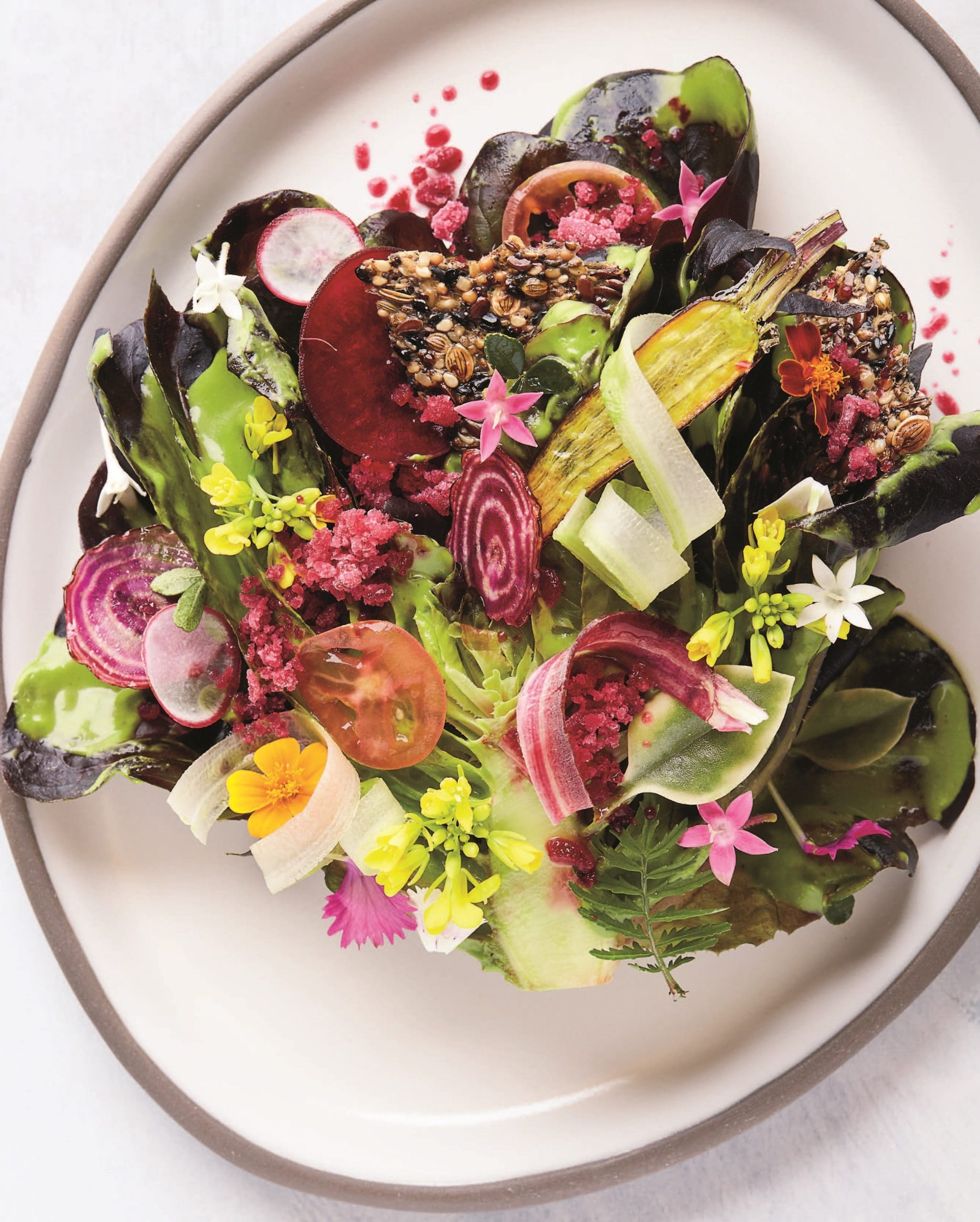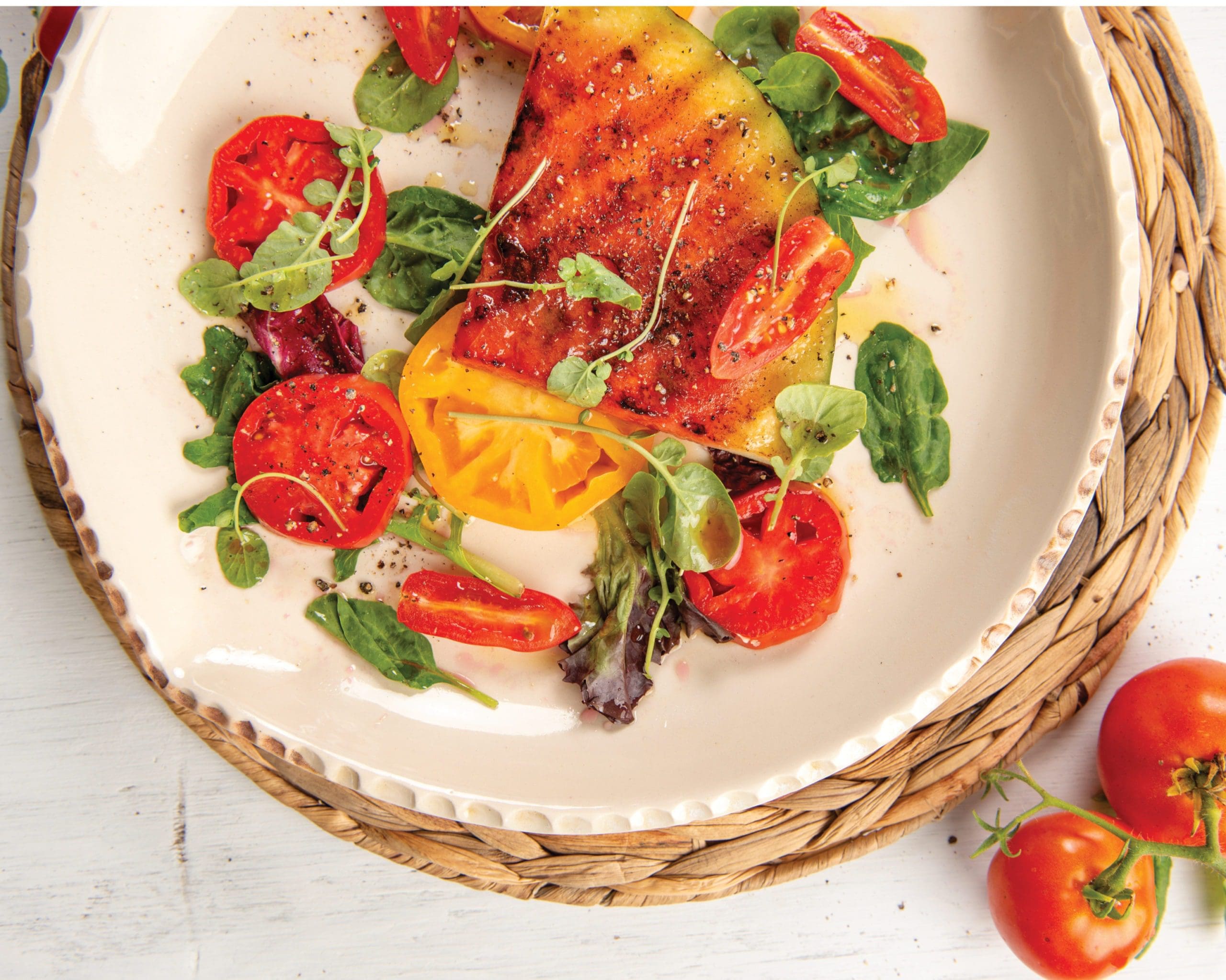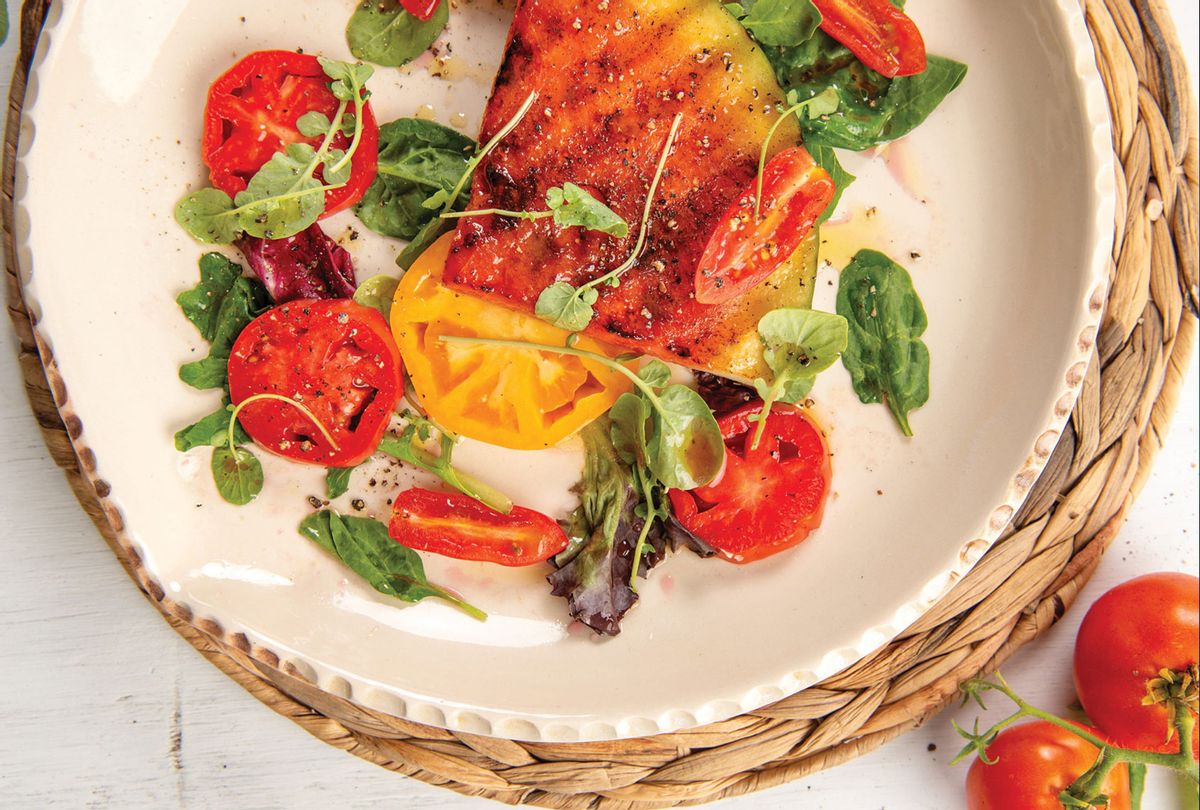There are many reasons summer is the salad season, but just to name a few: It's peak produce season, when fruits and vegetables are brimming with so much flavor, you don't need to waste time and energy cooking them. On the hottest days, nobody wants to cook anyway, and cool, crisp salads are a godsend. Tomatoes, cucumber, corn, green beans, peaches, watermelon, cherries — there are so, so many summer fruits and vegetables meant to salad. And yes, when we're talking about summer produce, "salad" is a verb.
Emily Nunn, who started her substack newsletter The Department of Salad in October 2020, as a paean to salads, likens summer salads to a drug. "Since I live in North Carolina, where the tomatoes and peaches and berries and other produce are luxurious and inexpensive and glorious, so were my salads," she writes in one of her first substack posts, waxing poetic on the gorgeous salads she made during last year's bitter pandemic summer. "It seemed that no matter how I arranged them, they were dazzling and delicious, like bouquets of flowers that you could eat. I layered fruits and vegetables and cheeses and herbs — and rather than making dressings I just sprinkled them with salt and olive oil and citrus juice. And these salads always made me happy."
Inspired by those perfect summer salads, Nunn went on, through her writing in the fall, winter, spring and now into summer again, putting "some concentrated thought" into making sure she always has a good salad. She's covered bean salad with bean aficionado Steve Sando, citrus salad in the dead of winter, and a creamy pimento cheese dressing, a delicious blessing and addictive curse for any fellow pimento cheese fans out there, showing that it's possible to make a good salad all year long.
Rethinking salads
According to Julia Sherman, visual artist and author of the cookbook "Salad for President," salad making is "a practice of putting disparate materials together." Speaking on the podcast Food Seen, she continues, "It's about comparing and contrasting, it's about juxtaposition, it's about complementary materials. I think there is something intuitive about salad making for artists and for a lot of people because they feel like they know that it's about arrangement and presentation more than it is about technique necessarily."
In "Salad for President" Sherman spotlights the recipes of artists, architects and musicians, so the emphasis on presentation is no surprise. But this description, of a salad being a combination of varying parts, can be just as true for a home cook reaching for a ripe summer tomato or a chef at a restaurant.
At The Culinary Vegetable Institute in Milan, Ohio, the wedge salad (recipe below) looks far from the classic chunk of romaine. With splashes and swirls of colors, it instead calls to mind a piece by Jackson Pollock. "Generally we'll have a baked component, a dried component, a frozen component, an emulsion, maybe two dressings, and a lot of different vegetables, flowers and herbs, all from the farm from that day," says Chef Jamie Simpson, who heads up the Institute's kitchen and developed the recipes in their new cookbook, "The Chef's Garden."
Each day the ingredients for their wedge salad may change, depending on what's available on the Institute's farm, but Simpson's team always follows the same mix of components. A recent early summer wedge salad featured lettuces, shaved green zucchini, asparagus and rhubarb, sweet English peas, celery leaves, chives, a rhubarb vinaigrette and frozen red onion granite.
 Wedge Salad from "From The Chef's Garden: A Modern Guide to Common and Unusual Vegetables" by Lee Jones. Image by Yossey Arefi.
Wedge Salad from "From The Chef's Garden: A Modern Guide to Common and Unusual Vegetables" by Lee Jones. Image by Yossey Arefi.
Thinking about salad components
While Simpson's wedge salad, with its emulsions and double dressing, might sound fancy, there are some good take-aways for the home cook when thinking about salad composition. Even for his home salads, Simpson pulls out the mandoline to shave his vegetables down to the same size. "I can bring carrots [and other ingredients] down to the width of a leaf of lettuce, and the way that eats on a fork is great," he says. "It's significant. There's no disruptive textures in there that really take additional energy or even distract you from the texture of the [lettuce] leaves."
When you think about salad as a mix of components, it can be the ultimate base recipe for waste free cooking. What can't you put into a salad? I once had a coworker lament that he paid $17 at the salad chain Sweetgreen for something nearly identical to the homemade use-up-my-leftovers salads I brought in for lunch. Think about having one of each component: something roasted, something crunchy, a tart element, a little sweetness, a few shaved vegetables like Simpson does, and something creamy. Toss leftover roasted vegetables, the last handful of toasted nuts, some goat cheese and a few fresh cherries into the greens, and my coworker could have done it too, also saving some money and food from being thrown away.
For Maria Zizka, author of the new cookbook "One Bowl Meals", thinking about salads via their components just makes things easier. As a new mom, Zizka is glad to have pre-prepped items to reach for. "A great thing about salads and the other one-bowl meals in my cookbook is that you can prepare the components ahead of time and store them in the fridge, ready to go when you need them," she recently told us via email. "Leafy greens can be washed and dried, dressings can be made, nuts and seeds can be toasted, and eggs can be soft-boiled."
Fresh and easy summer salads
Summer salads make things particularly easy for this type of thinking, since many of the fruits and vegetables are so flavorful they don't even need to be cooked. I just got back from a trip to New Orleans, where I ate as many raw Creole tomatoes — an early summer specialty in Southern Louisiana — as I could find. A heirloom varietal, they are just the thing to use in the watermelon and tomato salad (recipe below) from Matthew Raiford's new cookbook, "Bress 'n' Nyam: Gullah Geechee Recipes from a Sixth-Generation Farmer."
Raiford's recipes are inspired by his experiences growing up on his family's farm, living off the bountiful South Carolina land, where food is so fresh it doesn't need too much to bring out its best. As he shows, simple recipes can be full of flavor. He grills the watermelon to add smoky undertones, adds microgreens for a peppery bite, and dresses the salad with a sangria vinaigrette for tang.
No matter how simple or complicated, a good salad is really all about balance. Simpson balances the wedge salad with contrasting temperatures and textures. Raiford balances the sweetness of his tomatoes and watermelon with a tangy vinaigrette. Zizka suggests using herbs, such as a combination of purple basil, cilantro, and mint dressed with lemon or lime juice, oil and salt, to brighten up heavier salads. "Herb salad makes a beautiful addition to rice bowls, grain salads, and more," she wrote to us.
If you follow Sherman's definition of a salad as putting disparate materials together, thinking about how each component plays together, you'll succeed. Putting the "concentrated thought" into salad making that Nunn encourages, the best salad is the one that hits every beat.
"Recently on Instagram Live, my friend Phyllis (aka @dashandbella) taught me to make a roasted apricot salad with shaved Parmigiano cheese, mustard greens, and kalamata olives," Zizka said. "The fruit brings just enough sweetness to the party. I adore fruit in a salad, but you need to make sure that it doesn't overwhelm the other elements. Phyllis's salad nails the balance of salty, crunchy, and toasty."
***
 Watermelon Steak Salad with Heirloom Tomatoes and Sangria Vinaigrette from "Bress 'n' Nyam: Gullah Geechee Recipes from a Sixth-Generation Farmer." by Matthew Raiford and Amy Paige Condon. Photography © 2021 by Siobhán Egan.
Watermelon Steak Salad with Heirloom Tomatoes and Sangria Vinaigrette from "Bress 'n' Nyam: Gullah Geechee Recipes from a Sixth-Generation Farmer." by Matthew Raiford and Amy Paige Condon. Photography © 2021 by Siobhán Egan.
Recipe: Watermelon Steak Salad with Heirloom Tomatoes and Sangria Vinaigrette
Matthew Raiford and Amy Paige Condon, "Bress 'n' Nyam: Gullah Geechee Recipes from a Sixth-Generation Farmer."
Yield: Serves 4 to 6
I grew up eating Georgia Rattlesnake watermelons — that's really what they're called, because the dark green stripes resemble a diamondback rattlesnake. These heirloom varietals, which can grow up to 40 pounds, have a deep reddish pink flesh that is sweeter than sweet. Folks started growing them around here in the 1830s. When I was a kid, we'd throw them in the back of the truck and take them to market. Because they are harder to come by now, and because people have grown accustomed to seedless watermelons, I created this recipe to accommodate either. But I absolutely prefer a rattlesnake watermelon, which we grow at Gilliard Farms.
Ingredients:
For the salad
1 to 1 1/2 pounds freshly mixed salad greens or microgreens
1 pound heirloom tomatoes of varying sizes and colors, such as Cherokee Purple, Yellow Brandywine, black and yellow cherry tomatoes
1/4 medium seedless watermelon (5 to 10 pounds)
Olive oil for brushing
For the vinaigrette
1 cup traditional red sangria, either homemade or store-bought
1/2 cup olive oil
Freshly cracked black pepper
Sea salt
Method:
- Prepare your grill for medium-high direct heat, 375° to 450°F.
- While the grill comes up to temperature, wash and dry the salad greens, then divide the greens among four to six serving plates. Wash and dry your tomatoes. Slice the whole tomatoes into 1/2-inch rounds and halve the cherry tomatoes. Divide and arrange the tomato slices evenly among the plates. Set the plates in the refrigerator to chill while you finish the dish.
- Slice the watermelon into 3/4-to-1-inch-thick "steaks," then quarter the steaks into wedges. Brush each side of the watermelon with a little olive oil, then set the wedges on the grill for approximately 3 minutes per side, until you get grill marks. The longer you leave the wedges on, the sweeter they'll get. Remove the watermelon from the grill and arrange evenly among the salad plates.
- Pour the sangria into a large measuring cup with a pouring spout, then whisk the olive oil into the sangria until it makes a nice, loose vinaigrette. Generously dress the salads. Sprinkle the salads with pepper and salt to your liking, then serve.
Excerpted from Bress 'n' Nyam: Gullah Geechee Recipes from a Sixth-Generation Farmer. Copyright © 2021 CheFarmer Matthew Raiford and Amy Paige Condon. Photography © 2021 by Siobhán Egan. Reproduced by permission of The Countryman Press, a Division of W.W. Norton & Company. All rights reserved.
***
Recipe: Our Wedge Salad
Lee Jones, "From The Chef's Garden: A Modern Guide to Common and Unusual Vegetables"
Yield: Serves 4
We've had a lot of fun exploring the fundamentals of a classic wedge salad. You know the one: iceberg lettuce dressed with blue cheese dressing and topped with chopped bacon and black pepper. If you're lucky, you might even get half a cherry tomato.
Our wedge salad changes daily and represents a walk through the farm. We take a split young head of Merlot romaine (other dense, rigid heads of lettuce work fine) and garnish it with an assortment of shaved vegetables, flowers, and leaves we pick a mere few hours before serving. We encourage you to experiment with the combination of vegetables based on what you find that day. To finish, we dress the lettuce with an herb emulsion, which provides some creaminess, and a kombucha-based granita, for brightness. Crunchy, deeply flavored seed crackers finish the dish. These crackers are easy to make at home and have a long shelf life, but you can often buy similar seedy crackers at cheese shops and specialty markets.
Ingredients:
1 cup (240 ml) Herb Kombucha (page 609) or store-bought
2 cups (300g) shaved vegetables, such as carrots, asparagus, radishes, cucumbers, rhubarb, sunchokes, beets, or others
2 young heads sturdy lettuce, such as Merlot romaine, halved lengthwise
11/4 cups (300 ml) Herb Emulsion (page 607)
Flowers and herbs, for garnish
Seedy Crackers
Method:
- Pour the kombucha into a shallow baking pan, loaf pan, or ice cube trays. Freeze for at least 4 hours, until firm. Submerge all the shaved vegetables in ice water.
- Arrange the lettuce halves on a rack set over a rimmed baking sheet lined with parchment paper and dress with some of the herb emulsion. Season with salt.
- When ready to serve, use a fork to grate the kombucha into the baking pan (or process the ice cubes in a pre-chilled food processor fitted with the chilled grating disk, and store in the freezer until ready to serve.).
- Arrange the dressed lettuce halves on four plates. Divide the shaved vegetables among the plates. Pick a few blooms and herb leaves, and arrange them on the plates. Set a spoonful of the grated kombucha on top of each. Break a few pieces of the seed crackers into bite-sized pieces and add them to the salads. Serve immediately with more of the emulsion alongside.
***
Recipe: Herb or Vegetable-Top Emulsion
Lee Jones, "From The Chef's Garden: A Modern Guide to Common and Unusual Vegetables"
Yield: Makes about 3 cups
Whether it's squash leaves, bean leaves, carrot tops, excess herbs, or another leafy green, this emulsion allows you to turn those leaves that might otherwise get discarded into a smooth sauce. This basic emulsion serves as one of our mother sauces at the Culinary Vegetable Institute; we use it in salads, seafood dishes, and hot grains or warm vegetable appetizers. If you have a ton of herbs, you can make an herb oil first as a substitute for the sunflower oil, further fortifying the emulsion with flavor.
Ingredients:
8 ounces (225 g) herbs or vegetable tops, including stems
1 tablespoon plus 1 teaspoon
(20 ml) Dijon mustard
1/2 cup (120 ml) ice water
1 tablespoon (15 g) kosher salt, plus more to taste
2 cups (480 ml) sunflower oil
Method:
- Set a bowl of some ice water near the stove. In a pot of boiling salted water, blanch the herb leaves for about 20 seconds, until wilted. Transfer to the ice bath and let cool. Remove the herbs from the ice bath and squeeze out all excess water, then roughly chop.
- In a blender, combine the mustard, ice water, salt, and wilted leaves and blend on high speed until smooth. Scrape down the sides of the pitcher, then blend again until smooth. Ensure the puree doesn't get hot. With the blender now on medium speed, gradually add the oil. If the spinning slows or stops, increase the speed slightly to get it going again.
- Strain the emulsion through a fine-mesh strainer into a storage container. Taste and season with more salt, if desired. The emulsion will keep, refrigerated, for up to 1 week.
NOTE: Just before serving, you can brighten the flavor of the emulsion with a splash of citrus juice or vinegar, or some chopped pickles. Don't add the acidity too far in because it turns the emulsion brown over time.
From The Chef's Garden: A Modern Guide to Common and Unusual Vegetables–with Recipes by Farmer Lee Jones; with Kristin Donnelly, published by Avery, an imprint of Penguin Publishing Group, a division of Penguin Random House, LLC. Copyright © 2021 by The Chef's Garden, Inc.




Shares